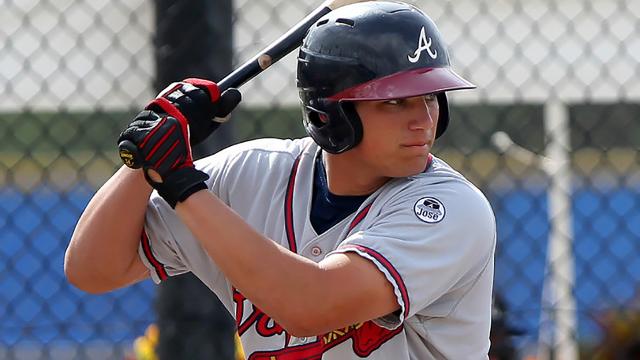
Continuing my charge through the Braves minor league prospects, here’s my #11-15 rankings, including a relative newcomer at #15.
11. Austin Riley, 3B
Age: 20
Bats: R
2016 Level: Rome
.271/.324/.479
128 wRC+
22 HR, 3 SB
7.3 BB%, 27.3 K%
The History: Riley was a 1st-round supplemental pick, a pick that the Braves acquired in the Craig Kimbrel trade. A two-way star in high school, most teams were scouting Riley as a pitcher, but the Braves liked his raw power and drafted him as a third baseman. Strong performances in the rookie leagues (.304/.389/.544 with 12 HR) and then in instructionals lead the Braves to assign Riley to class A Rome to start 2016. Riley struggled in the first months of the season, but Riley dramatically improved his production in the second half of the season. Riley hit 15 of his 22 home runs after July 1 and raked to a .282/.347/.568 clip to help propel Rome to the South Atlantic League playoffs. Riley added two more homers in the playoffs and knocked in 8 runs. After the season, Riley was named the #13 prospect in the South Atlantic League.
The Report: Riley represents the top prospect in the Braves organization in terms of in-game power. Riley doesn’t generate the power through exceptional bat speed, but from the raw strength of his 6’-2”, 230 pound body. Riley’s swing has a natural uppercut that can produce loft, and when he has his arms and hips moving through the zone in sync he can hit the ball out of any ballpark. The concern with Riley’s offensive game is his bat-speed. Early in the year, Riley would have to start his swing early in order to keep up with good fastballs, which also made him susceptible to breaking pitches, causing him to strikeout 30+% of his plate appearances. Riley made good in-season strides to remedy this, but it still remains a point of concern. Defensively, Riley is a work-in-progress. While he has a plus arm for third, Riley doesn’t have the natural instincts of a good third baseman. He also isn’t particularly sure-handed and his range is average at best. Some of this can be chalked up to Riley’s relative inexperience at the position, since he mostly pitched in high school, but there is a real chance Riley will have to move to an outfield corner or first base. On the bases, Riley can move quickly once he gets up a head of steam and will be aggressive to take the extra base.
What’s Next: Riley is one of the most exciting position player prospects in the organization because of his potential power. His path to the majors will be dictated on his continued adjustments to better pitching and how well he adapts to third base. There’s still a good bit of risk with Riley as there’s not many players that make it in the majors with slow bat speed, and if he has to move off third base that bat will have to carry him. Riley will take his next step in class A+ Florida in 2017.

12. Dustin Peterson, OF
Age: 22
Bats: R
2016 Level: AA Mississippi
.282/.343/.431
124 wRC+
12 HR, 4 SB
7.8 BB%, 17.3 K%
The History: Peterson was a 2nd-round pick of the San Diego Padres in the 2013 and was part of the package of players Atlanta received in the Justin Upton trade before the 2015 season, along with IF Jace Peterson (no relation), OF Mallex Smith, and LHP Max Fried. Drafted as a third baseman, the Braves immediately converted him to the outfield full time. Peterson started 2015 in class A+ Carolina, and looked like he was on the verge of an offensive breakout when he suffered severe whiplash in the team bus crash of late May. While he returned after 3 weeks, the effects of the crash seemed to linger through the dog days, and his overall numbers (.251/.317/.348) ended up being fairly pedestrian. On the basis of strong showings in instructionals and spring training, the Braves challenged Peterson with an assignment to AA Mississippi. Peterson responded impressively despite being one of the youngest position players in the league, with a career high OPS and finishing second in the Southern League in RBI (88) and fourth in slugging (.431). Peterson’s power started to emerge about 1/3 through the season, and while his 12 HR total may not seem that great, Mississippi’s Trustmark Park has one of the largest outfield dimensions in the minors, and several fly balls that would have been homers in neutral parks ended up being one of his league-leading 38 doubles. After the season Peterson was named the #12 prospect in the Southern League by Baseball America and the Organizational Position Player of the Year by the Atlanta Braves. Peterson was chosen by the Braves to play in the Arizona Fall League and played well, hitting .324/.352/.471 in 68 at-bats.
The Report: Peterson has an advanced hitting approach and the bat speed to be a source of power in a big league line-up. Peterson’s swing can get long which makes him susceptible to high velocity, but otherwise he has simple mechanics that he repeats nearly every plate appearance, a near-complete turnaround from the complex high leg-kick and multiple hitch-swing he showed when he first joined the organization. While Mississippi played Peterson occasionally in center field, Peterson profiles as a corner outfielder due to his lack of speed. Peterson does get good jumps on the ball and has an above-average and accurate arm. Peterson is a smart baserunner who can take advantage of a pitcher not paying attention to him and will take the extra base.
What’s Next: Peterson doesn’t have all the tools that some of the other high-profile position players in the system possess, but there’s not a lot of holes in his game at this point either. His floor seems to be a strong 4th outfielder, but could be a solid starting contributor. Peterson will likely start 2017 in AAA Gwinnett, and he could be the first outfielder called up if there is an injury or trade.
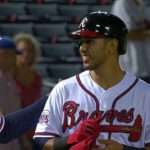
13. Rio Ruiz, 3B
Age: 23
Bats: L
2016 Level: MLB Atlanta
.271/.355/.400
118 wRC+
10 HR, 1 SB
11.4 BB%, 21.8 K%
(AAA only)
The History: Ruiz was a 4th-round pick in 2012 by the Houston Astros and was traded to Atlanta along with right-handed pitchers Mike Foltynewicz and Andrew Thurman for DH Evan Gattis before the 2015 season. Coming off a strong season with the Astros’ high-A affiliate, and with no strong third base prospects in the pipeline for Atlanta, hopes were high for Ruiz as he began the season at AA Mississippi as one of the youngest players in the Southern League. Unfortunately, Ruiz started very slowly out of the gate. While exhibiting an advanced batting eye, Ruiz had a tendency to roll over the ball when he made contact, and he struggled throughout most of the season. Ruiz continued to work on his batting mechanics, and he seemed to turn a corner late in the season, batting .285/.350/.472 from August 1 through the end of 2015. It’s been well-publicized that John Hart personally challenged Ruiz to work on his conditioning in the offseason, and Ruiz arrived in spring training noticeably slimmer and moving better. His good work prompted the Braves to give Ruiz with a surprisingly aggressive AAA assignment. Despite being the youngest position player in AAA, Ruiz was a strong performer at Gwinnett, though he suffered a set-back in May while playing through a strained oblique. Ruiz was rewarded with a September call-up to Atlanta, where he had two hits in 7 plate appearances, including a triple.
The Report: Ruiz is a disciplined hitter who can make good contact to all fields, but is at his best when he can pull the ball for line drives. Ruiz worked last season to simplify his load to make his bat faster on inside pitches, and that work paid off as Ruiz was noticeably quicker to the ball. Even when he struggles, Ruiz will maintain a solid OBP by working counts and drawing walks. For the first time in his pro career, Ruiz did exhibit a sharp platoon disadvantage against left-handed pitchers, likely due to the level of competition he faced. In the field, Ruiz improved from below-average to above-average last season as his improved conditioning played off in increased range and better first steps to the ball. Ruiz has shown good hands and an above-average to plus arm for third base. Improved conditioning also improved his baserunning; while he won’t be a basestealer, Ruiz has a good step out of the box and will take the extra base.
What’s Next: After being a position of weakness for the Braves system, third base should now be considered a strength. Austin Riley, Travis Demeritte, Juan Yepez, and Kevin Maitan are all prospects that could see time at third base for Atlanta in the future, but Rio Ruiz is the closest to the majors right now. Ruiz will most likely start the season back in AAA Gwinnett, but there’s a possibility that he could start in Atlanta as a platoon-mate with Adonis Garcia. If he builds on the strides he made last season and evens out his production against left-handed pitchers, Ruiz could be the everyday third baseman in SunTrust Park before the end of 2017.

14. Patrick Weigel
Age: 22
2016 Level: AA Mississippi
2.57 ERA
3.61 FIP
27 G, 26 GS
157.1 IP
3.55 BB/9, 9.21 SO/9
(stats from A and AA levels)
The History: Weigel was Atlanta’s 7th-round pick in the 2015 draft out of the University of Houston. Coming into the draft, the book on Weigel was that he was a hard thrower without a lot of control and mediocre secondary offerings, and many scouts didn’t see much more than a fringe reliever. The Braves obviously thought they could do something with him however, and officials would point to Weigel as a potential “steal”. His first season in Danville (4.53 ERA, 4.5 BB/9, 8.5 SO/9) didn’t exactly blow anyone away, but he also showed he wasn’t just the brain-dead thrower that he was advertised to be. In 2016 he was included with heralded starters and first-rounders like Mike Soroka, Touki Toussaint, and Max Fried in the Rome starting rotation and became the team’s most reliable workhorse with a 2.51 ERA and leading the team in innings per start. In late August, the Braves decided to challenge Weigel with a promotion, skipping the high-A level completely and going straight to AA Mississippi. If Weigel was intimidated by the promotion, he didn’t show it, pitching to a 2.18 ERA his last three regular season starts. Weigel pitched 7 innings of shut-out ball against Pensacola in the Southern League Division Series and was the Game 3 starter for the Championship Series, but he didn’t have it that night, only getting two outs and giving up 4 runs before being pulled. Nevertheless, it was a remarkable season for Weigel, who was named the #10 prospect in the South Atlantic League by Baseball America and the Organizational Pitcher of the Year by the Atlanta Braves after the season.
The Report: Weigel is an imposing 6’-6”, 220 pounds and he uses that length and sturdiness to generate quick acceleration to the plate. He has a 3-quarters arm slot delivery that he repeats well. Despite the early reports of control problems, Weigel spots his fastball well, and he will sit in the mid-90s late into games, and even touched triple digits on occasion. His slider has a late-breaking downward slant that works as a good swing-and-miss offering. His curveball, considered pretty much a disaster when drafted, now is a potential plus pitch, a tight loop that can be difficult for hitters to distinguish from his slider until it breaks out of the zone. His change-up is still a work in progress, and his move to AA will force him to have to throw it more.


What’s Next: No pitcher in the Braves organization improved his stock more than Weigel this season. He has electric stuff and three potential plus pitches, and if the change-up develops the Braves could have a potential top-of-the-rotation jewel that they stole in the 7th round of a draft. Weigel will likely start the season back in AA Mississippi, but could be a fast riser in 2017.
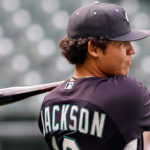
15. Alex Jackson, OF
Age: 21
Bats: R
2016 Level: Class A Clinton
.243/.332/.408
120 wRC+
11 HR, 2 SB
8.9 BB%, 27.0 K%
The History: Jackson was the 6th overall pick in the 2014 draft by the Mariners, and was traded to the Braves for right-handed pitchers Rob Whalen and Max Povse on November 29, 2016. Jackson was a high school star in California and was MLB.com’s #28 prospect in the minors in their pre-2015 Top 100 list. So far Jackson hasn’t been able to live up to that hype. In 2015 he battled shoulder and hand injuries to hit a meager .207/.318/.365 between low- and mid-A levels. Jackson was held back in extended spring training to work on his mechanics and didn’t get assigned back to class-A Clinton until mid-May. Jackson started slow, but did perform better in the second half. From July 1 through the end of the season, Jackson hit a respectable .257/.346/.406 with 5 HR.
The Report: Jackson has plus bat speed that can generate very good raw power. In 2015, perhaps as a consequence of his injuries, Jackson’s upper half became very stiff and his swing much jerkier. That looks to have smoothed out over the course of 2016, but his arms can get a little long, especially when chasing outside breaking balls. Jackson has a solid approach at the plate, but has some pitch recognition issues, but those can be ironed out with repetition. Scouting reports have Jackson as an average outfielder with a plus arm. Jackson was a catcher in high school, but was immediately moved to the outfield to save his body and allow him to concentrate on his hitting. The Braves may elect to move him back to catcher, which will likely slow his minor league advancement, but give him more long-term advancement opportunities. His defensive scouting reports from high school show him with good pop times and a plus arm, but some question about his blocking skills.
What’s Next: Jackson is an intriguing prospect, and his power potential will afford him a lot of chances to get on a good advancement path. If he remains in the outfield, he will likely start 2017 in class A+ Florida, but if the Braves do have him go back to catching he may start a second season in extended spring training before getting his minor league assignment.
Outfield Fly Rule Prospect List:
- Dansby Swanson
- Ozzie Albies
- Kolby Allard
- Mike Soroka
- Sean Newcomb
- Kevin Maitan
- Touki Toussaint
- Max Fried
- Ian Anderson
- Ronald Acuña
- Austin Riley
- Dustin Peterson
- Rio Ruiz
- Patrick Weigel
- Alex Jackson

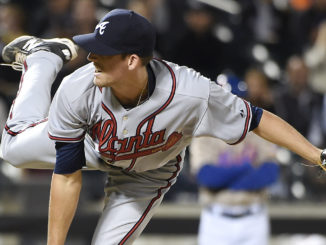
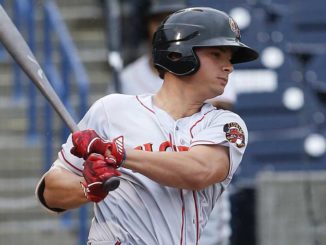

Leave a Reply